S-class: Difference between revisions
Pbcjohnston (talk | contribs) No edit summary Tags: Manual revert Reverted |
Pbcjohnston (talk | contribs) Fixed formatting |
||
| (53 intermediate revisions by 2 users not shown) | |||
| Line 1: | Line 1: | ||
{{#seo:|title=S-class submarines U.S. Navy - PigBoats.COM|title_mode=replace|keywords=S-boat, sugar boat, US S-class submarine}} | |||
{{#seo:|description=Notes, photographs, and pictures of the U.S. Navy's S-class submarines.}} | |||
< | [[File:New Header EB S-boats.jpg]] | ||
==S-1 and S-18 through S-29 (EB design built at Bethlehem Quincy)== | === <big>Design and Construction Notes</big> === | ||
<div style="text-align: justify;"><span style="color:#00008B">The 51 S-class open ocean patrol submarines marked the transition away from the harbor and coastal defense strategic concept that had dominated USN submarine doctrine since 1900. The concept that drove their design was offensive in nature, with the intention of having the S-class cross the Atlantic to carry the fight to a potential enemy. Significantly, this class also marked the emergence of the USN as its own design agent, with 19 of the boats built to a design developed for the first time by the Navy's Bureau of Construction & Repair. This effectively ended the Navy's total reliance on private contractors for submarine design work, forever altering the established paradigm of submarine acquisition. They were built to five distinctly different designs with several variations at four different shipyards. The designs were from the Electric Boat Company (EB) of New York City (later Groton, CT.), the Lake Torpedo Boat Company (LTB) of Bridgeport, CT., and the Portsmouth Navy Yard in Kittery, ME. While similar in military and operational capability, the various designs were vastly different in installed equipment, interior arrangement, and external appearance and essentially the 51 boats were a class in name only. The details can be confusing, so if you are interested in sorting it all out, we highly recommend perusing the Visual Guide articles at this link: [https://pigboats.com/index.php?title=Johnston,_David '''A Visual Guide to the S-class Submarines 1918-1945 Parts 1, 2, & 3''']. Also, we also have some of the pages from the General Information Book for the S-1. The book has some interesting data that is applicable to the EB design for the S-class. It can be found at this link: [[S-1 General Information Book 1924|'''S-1 General Information Book 1924''']]. | |||
This was the largest class of submarines built for the USN prior to WWII, and they became ubiquitous in every fleet operating area in the 1920's and 1930's. However, because they were a WWI design, they were rapidly aging by 1941. Due to a lack of modern fleet submarines, the extant S-boats were pressed into war service throughout the Pacific and western Atlantic. Many of them were in the thick of the fight against the Japanese from the first day of the war. The high intensity operations took a toll on them, with six (marked by a *) being lost. Three were lost to grounding, one to a collision with a friendly warship, one to hull failure during a training mission, and one loss to enemy action (S-44). The crew members that died in service are considered to be "on eternal patrol". | |||
The class is broken down by groups below. | |||
[[File:Red bar sub new 2.jpg]] | |||
<div style="text-align: justify;"><span style="color:#000000"> | |||
=== <big>S-1 and S-18 through S-29 (EB design built at Bethlehem Quincy)</big> === | |||
[[File:EB sboats.jpg|left|500px|Photo from the private collection of Ric Hedman.]]<div style="text-align: justify;"><span style="color:#00008B">Elements of Submarine Division 4 alongside the pier at Coco Solo, Panama, March or April 1927. Not all of the boats can be positively identified. Left to right: S-19, possibly S-18, S-27, S-1, S-22, and unknown. All of the boats have their T-shaped radio mast raised, with aerial wires running from the mast down to the bow and stern. These long wires provided long range communication.</span> | |||
[[S-1 and S-18 through S-29|See more of this group]] | [[S-1 and S-18 through S-29|See more of this group]] | ||
< | [[File:Red bar sub.jpg]] | ||
[[File: | |||
< | === <big>S-2 (Lake design built at Lake Torpedo Boat Company)</big> === | ||
[[File:H41993.jpg|left|500px|Photo NH 41993 courtesy of the Naval History & Heritage Command.]] | |||
< | <div style="text-align: justify;"><span style="color:#00008B">S-2 while on sea trials in 1919, prior to commissioning. S-2's bow planes retracted into the superstructure horizontally, the EB design had the bow planes retracting at an angle. Trials showed that she had the tendency to burrow into the waves due to a lack of buoyancy forward. S-2's bow would be soon modified with an additional bow buoyancy tank, giving her a distinctive humped appearance. Her chariot style bridge fairwater has not yet been added. S-2 does not have a deck gun installed in this photo. She would later have a 4"/50 caliber Mk 9 gun installed forward, requiring the installation of a large deck sponson around the gun.</span> | ||
[[S-2|See more S-2 photos]] | [[S-2|See more S-2 photos]] | ||
< | [[File:Red bar sub.jpg]] | ||
[[File: | |||
< | === <big>S-3 through S-9 (Government design built at Portsmouth Navy Yard)</big> === | ||
[[File:Gov Sboats.jpg|left|500px|Photo from the private collection of Ric Hedman]] | |||
< | <div style="text-align: justify;"><span style="color:#00008B">A portion of Submarine Division 12, consisting of S-4, S-8, S-6, and S-9 alongside the pier at Coco Solo, Panama, March or April, 1927. S-4 would be lost in a tragic accident off Provincetown, MA. just eight months later.</span> | ||
[[S-3 through S-9|See more of this group]] | [[S-3 through S-9|See more of this group]] | ||
<br><br><br><br>< | |||
[[File:Red bar sub.jpg]] | |||
=== <big>S-10 through S-13 (Modified Government design built at Portsmouth Navy Yard)</big> === | |||
[[File:S-10 group.jpg|left|500px|Photo courtesy of the Naval History & Heritage Command.]]<div style="text-align: justify;"><span style="color:#00008B">S-13, S-10, and S-12 moored alongside the Balboa Docks, Panama, approximately 1935. Temporary canvas awnings have been erected forward of the conning tower fairwaters in an attempt to ward off the tropical heat. These boats did not have air conditioning. They all have received the safety modifications enacted after the S-4 sinking. The forward rescue buoys can be seen on the starboard side, just forward of the boat's name. They are painted black, a force wide effort that began in 1934. Previously all USN submarines were the standard battleship (haze) gray.</span> | |||
[[S-10 through S-13|See more of this group]] | |||
[[File:Red bar sub.jpg]] | |||
=== <big>S-14 through S-17 (Government design built by Lake Torpedo Boat Company)</big> === | |||
[[File:S14 group.jpg|left|500px|USN photo courtesy of Darryl Baker.]]<div style="text-align: justify;"><span style="color:#00008B">A fine bow view of S-14 and S-17 alongside at the Mare Island Navy Yard in Vallejo, CA., September 23, 1927. Very noticeable in this photo is the starboard side mounted anchor, the retracted bow diving planes, and the flared out deck sponson for the 4"/50 caliber Mk 9 deck gun.</span> | |||
[[S-14 through S-17|See more of this group]] | |||
[[File:Red bar sub.jpg]] | |||
=== <big>S-30 through S-41 (EB design built at Bethlehem San Francisco)</big> === | |||
[[File:1div17.jpg|left|500px|Photo courtesy of the Naval History & Heritage Command.]]<div style="text-align: justify;"><span style="color:#00008B">Elements of Submarine Division 17 moored in a nest at Tsingtao, China, early 1930's. Left to right: S-36, S-39, S-32, S-37, and S-41. Tsingtao (now Qingdao), on the Yellow Sea, was a frequent port of call for Asiatic Fleet submarines in the pre-war years. The boats have only recently arrived from what is likely a division level exercise at sea, and the much anticipated liberty call had not yet been announced. The sailors are milling about topside, chatting with each other, trying to beat the oppressive heat below. This photo gives a good view of the 4"/50 caliber Mk 9 gun that these boats were equipped with, and unusually all of the guns are elevated skyward.</span> | |||
[[S-30 through S-41|See more of this group]] | |||
[[File:Red bar sub.jpg]] | |||
=== <big>S-42 through S-47 (Modified EB design built at Bethlehem Quincy)</big> === | |||
[[File:S42 series.jpg|left|500px|Photo NH 96624 courtesy of the Naval History & Heritage Command.]]<div style="text-align: justify;"><span style="color:#00008B">An outstanding photo of Submarine Division 19, July 28, 1928 at San Diego. Left to right: S-46, S-42, S-47, S-43, S-44, and S-45. A lot of very interesting details of these boats can be seen. The crews are all turned out in their dress blues, and if anyone can identify any of these sailors, please let us know.</span> | |||
[[S-42 through S-47|See more of this group]] | |||
[[File:Red bar sub.jpg]] | |||
=== <big>S-48 through S-51 (Modified Government design built by Lake Torpedo Boat Company)</big> === | |||
[[File:S-51 s-50-1.jpg|left|500px|Official USN photo, a copy of which is in the private collection of Ric Hedman.]] | |||
<div style="text-align: justify;"><span style="color:#00008B">S-51 and S-50 maneuvering close alongside, somewhere in the Caribbean, spring of 1924. This group represented the final iteration of the Government S-boat design. They were longer and heavier, and were equipped with a stern torpedo tube. Unfortunately, they were slow divers with poor underwater maneuverability. Not well liked by the Navy, S-49 and S-50 were disposed of under the terms of the London Naval Treaty in 1930. S-51 had been lost in a collision in 1925. Only S-48 survived through WWII, and only because she had been extensively modified in an attempt to improve her performance.</span> | |||
[[S-48 through S-51|See more of this group]] | |||
[[File:Red bar sub.jpg]] | |||
=== <big>S-class general and group photos</big> === | |||
[[File:S-boats 30 series nest canopus 2.jpg|left|500px|Photo courtesy of the NHHC.]] | |||
<div style="text-align: justify;"><span style="color:#00008B">USS Canopus (AS-9) and her brood of 30 series S-boats, anchored at Tsingtao (now Qingdao), China, mid 1920's. The submarines are, left to right: S-37, S-40, S-36, S-38, S-41, and S-39. | |||
[[S-class group photos|See more group photos]] | |||
[[File:Red bar sub.jpg]] | |||
<center> | |||
<span style="color:#00008B"> | |||
Page created by:<br> | |||
<small>Ric Hedman & David Johnston<br> | |||
1999 - 2023 - PigBoats.COM<sup>©</sup><br> | |||
Mountlake Terrace, WA, Norfolk, VA<br> | |||
webmaster at pigboats dot com</small> | |||
</center> | |||
[[File:Subs bottom line 2.jpg]] | |||
Latest revision as of 12:42, 19 July 2025
Design and Construction Notes
This was the largest class of submarines built for the USN prior to WWII, and they became ubiquitous in every fleet operating area in the 1920's and 1930's. However, because they were a WWI design, they were rapidly aging by 1941. Due to a lack of modern fleet submarines, the extant S-boats were pressed into war service throughout the Pacific and western Atlantic. Many of them were in the thick of the fight against the Japanese from the first day of the war. The high intensity operations took a toll on them, with six (marked by a *) being lost. Three were lost to grounding, one to a collision with a friendly warship, one to hull failure during a training mission, and one loss to enemy action (S-44). The crew members that died in service are considered to be "on eternal patrol".
The class is broken down by groups below.
S-1 and S-18 through S-29 (EB design built at Bethlehem Quincy)
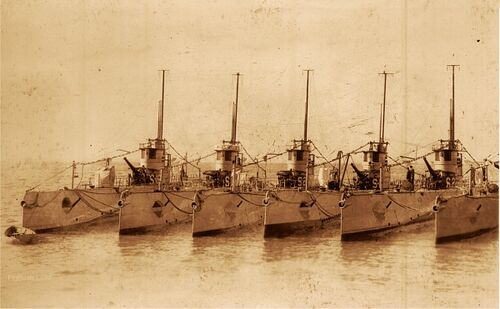
S-2 (Lake design built at Lake Torpedo Boat Company)
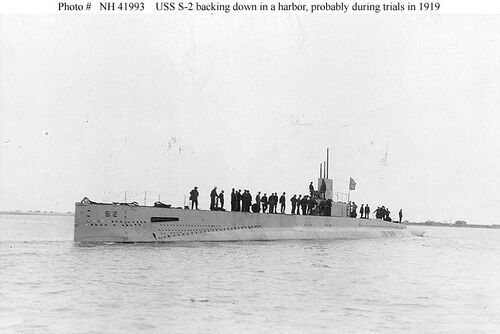


S-14 through S-17 (Government design built by Lake Torpedo Boat Company)
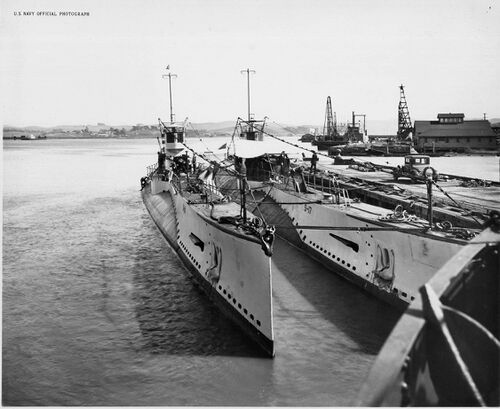
S-30 through S-41 (EB design built at Bethlehem San Francisco)
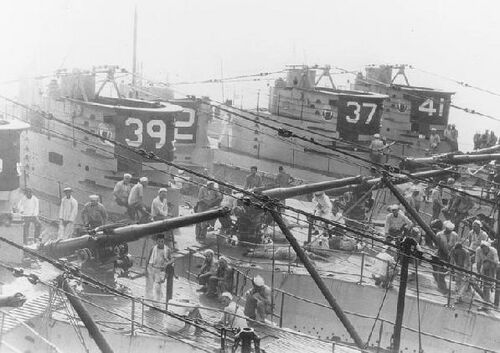
S-42 through S-47 (Modified EB design built at Bethlehem Quincy)

S-48 through S-51 (Modified Government design built by Lake Torpedo Boat Company)
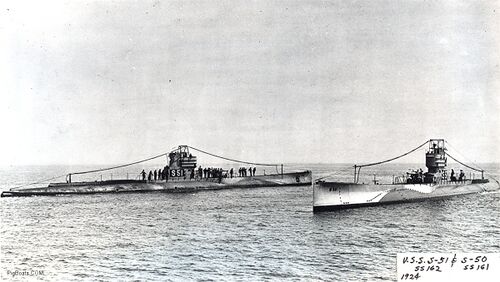
S-class general and group photos
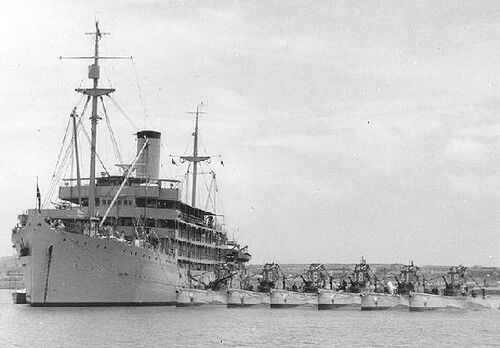
Page created by:
Ric Hedman & David Johnston
1999 - 2023 - PigBoats.COM©
Mountlake Terrace, WA, Norfolk, VA
webmaster at pigboats dot com
